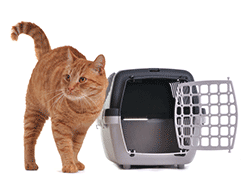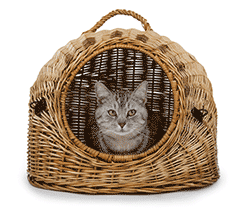Transporting Your Cat
Getting your cat into a cat carrier or cage and going on a journey can be very distressing for your cat

The carrier
There are all shapes and sizes of carrier on the market, from simple wire cages to multi-functional designs. Look for carriers which have a removable top or large opening to get your cat in - trying to get a protesting cat through a small hole can be difficult. Easy to use locking catches are helpful and their should be just enough room for your cat to turn around. The base of a carrier should ideally be plastic or contain a plastic tray so that any urine or vomit is held in the container - it is a good idea to lay down some newspaper and a blanket to make your cat more comfortable and to soak up any accidents. More advanced carriers on the market can be found with seat belt fittings, separate compartments for housing more than one cat, washable covers, carrying straps, food and drink dispensers, fabric cushioning, foldable frames and just about any other extra you can think of.
Preparing for transporting a cat
Even for small trips it is worth doing a bit of preparation to reduce the stress on your cat and make the journey as smooth as possible. Whilst some cat owners hide away carriers until the last minute in order to 'surprise' the cat, all this does is reinforce the connection between the carrier and an unpleasant event. It is better to allow the cat to familiarise itself with the carrier, rub some scent on it and mark it as its own. Keep the carrier out for a few days before the journey to allow your cat to get used to it, you can even use it as a play area or place some of your cat's bedding in it to encourage its use as a sleeping area. On the day of the journey don't let your cat outside, cats can often sense when something is going on and may ignore calls to come inside.
Food and drink for your cat when travelling
It is best to avoid giving your cat any food for at least an hour before any journeys to reduce the chance of your cat needing to toilet or vomit. If your journey is for more than a couple of hours you should provide water for your cat, and if it is more than three or four hours you can provide a very small amount of dried food.

Wicker carriers are stylish, but not very functional
Taking your cat on long journeys
In most cases you will only need to take your cat out for short trips to the vet, or a cattery or friends house when you go on holiday, but if you need to take a journey of several hours it would be wise to prepare your cat for the event. The best way to do this is by familiarising your cat with short trips out in the car. You can start by just putting your cat in the carrier and sitting in the car without going anywhere for five minutes, then progress to short journeys of ten to fifteen minutes and even a few longer thirty minute journeys. After each of these trial runs give your cat a treat and plenty of fuss, your cat should soon get used to travelling and will be well prepared for a longer journey.
The journey
Leave the cat as the last thing to put in the car, leaving him locked in a carrier in the house will only prolong the confusion. When ready take the carrier and place it securely on the car seat and if possible attach the seat belt. Start the engine and reassure your cat by talking calmly before gently pulling away. Make sure you drive steadily and carefully, your cat may show strong signs of distress but do not let it distract you from driving. Ideally your cat should be able to see you but not the outside world, if your carrier has too many windows or is see-through you can place a light sheet over the top, but make sure there's still plenty of ventilation.
Noisy cats
Cats will normally meow loudly and constantly when moved in a carrier, this can be uncomfortable for a loving owner to witness but it is important to remember that your cat is in no danger and anything you do to prolong the journey (such as stopping to offer comfort) will just prolong your cats misery. In most cases a cat will settle down, and sometimes even go to sleep once they realise the situation is not going to change. Having the radio on can help by reminding the cat of home or masking the noise of vehicles. It can help to have another person that the cat knows to sit next to the carrier and provide comfort, but never be tempted to allow the cat out of the carrier even if the cat seems settled - this is a sure way to cause an accident.
Extreme reactions
Cats often show signs of motion sickness which can be seen as vomiting, drooling, panting, or toileting. If your cat does this while traveling it is not coping very well with the situation. If your journey is to end within the next 10-15 minutes just carry on and get your cat to its destination. If you still have a long way to go it may be better to pull over and give your cat some reassurance, offer some water and clean up any mess. Again, only do this if really necessary as it is prolonging the journey. You can help a cat that reacts badly to travelling with some herbal pills or a bit of catnip in the carrier and in extreme cases your cat can be mildly sedated. Make sure you get advice from your vet before using any medications.
Arrival
Upon arrival at your destination, first put the carrier down and talk to your cat for a few seconds, then slowly open up the carrier and assess your cats mood. Your cat may want to just 'jump and run', or it may appreciate some reassuring contact from its owners. Have some of its favourite treats ready as a reward. Remember if you are visiting a vets to keep your cat in its carrier whilst you are waiting to be seen. Despite all the load meowing, crying and protesting, cats will usually settle down quite soon after transport and will probably enjoy an evening of bonding after their ordeal.


